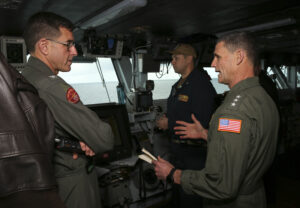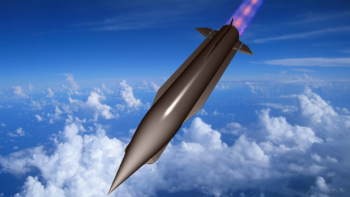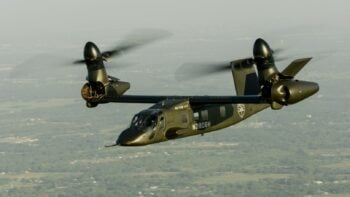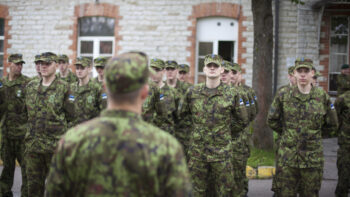
E-2D Hawkeye
MILCOM 2019: The Chief of Naval Operations and the Air Force Chief of Staff will work to link their separate command & control networks into a single Joint All-Domain C2 system, Vice Adm. Andrew Lewis told Breaking Defense today. Swift and seamless exchange of information among all four services’ forces in all five domains (land, sea, air, space, and cyberspace) is crucial to the future Multi-Domain Operations envisioned by the Air Force and the Army — but until now the Navy had not signed on.

Vice Adm. Andrew Lewis (right) aboard the USS Abraham Lincoln.
“I had an email discussion with the CNO not long ago about this very thing,” said Lewis, head of both the Navy’s Second Fleet and Joint Forces Command Norfolk, in a conversation on the sidelines of AFCEA’s annual military communications (MILCOM) conference in Norfolk, Virginia. Lewis said he wasn’t sure whether the agreement was yet formalized — the specifics are “kind of above my pay grade” at “the service chief level,” he said — and it’s not clear if a signed, official document even exists. But he stressed that the important thing is the recognition that the issue of All-Domain or Multi-Domain C2 is fundamentally a joint issue.
“It needs to be a full joint grid that is fully integrated. No matter what we call it, we just need to do it,” he said, adding that a “lot needs to be worked” to make it happen.
One Air Force official told Breaking D that “I don’t believe there was a written agreement, but the Air Force has transitioned to using the terminology, Joint All Domain C2.”
JADC2 is the term of art the Joint Staff has put forward for a C2 network that would link all US military sensors to all shooters in near real-time. Until recently, the Air Force term of art has been Multi-Domain Command and Control (MDC2), a concept the Army has embraced.
“Moving to use the JADC2 terminology recognizes the Air Force is actively working with the rest of the joint force to pursue future technologies to build a digital foundation from which we can all share, connect and learn,” the official said.

Gen. Mike Holmes
Indeed, Lewis’ call for a joint C2 network was echoed here today by Air Combat Command head Gen. Mike Holmes. Speaking to the MILCOM 2019 conference this morning, Holmes said bluntly that the US military needs “purple command and control.”
He said that wargame after wargame has shown that in the face of current Russian and Chinese capabilities, especially in the electronic warfare and cyber arena, the current US military approach to C2 on the battlefield simply doesn’t work.
“We could not move fast enough trying to do ‘green’ command and control in the Army, ‘light blue’ command and control in the Air Force, and ‘dark blue’ command and control in the Navy,” Holmes said. “We need purple, and we need to come together and do it in one place.”
The end-goal, Holmes stressed, is to “generate offensive and defensive effects from all domains.”
According to Lewis, the man responsible for figuring out how to work with allies in the Atlantic and the ever more contested Arctic maritime domain, that is not possible right now. “We have Navy-only systems,” he said, “which is really frustrating.”
For example, the Navy has invested heavily in a network called Navy Integrated Fire Control-Counter Air (NIFC-CA), which links airborne sensor platforms to surface ships. NIFC-CA allows E-2D Advanced Hawkeye radar planes and F-35C Joint Strike Fighters to spot enemy aircaft or incoming missiles, then transmit the data to Aegis cruisers and destroyers, or even Littoral Combat Ships, which can then fire on targets they can’t see with their own radars. The goal is to combine the long sensor range of aircraft with the much heavier firepower of surface ships.

Aegis ships firing missiles
NIFC-CA has done some work to integrate the Army’s cancelled Joint Land Attack Cruise Missile Defense Elevated Netted Sensor System (JLENS). But otherwise, “it’s a Navy-only system, which is asinine,” Lewis said. “We have needs across all domains. … That’s one of those challenges we’re working through, and it’s recognized that we have to.”
The Air Force, as Breaking D readers know, believes that its Advanced Battle Management System (ABMS), will eventually evolve into a joint system. That is, ABMS, in the Air Force’s view, will become the one C2 and battle management system for all US military operations — linking all sensors owned by all services (and even the Intelligence Community) across all five domains.
This, of course, will require buy in from the Navy and the Army — something that cannot be taken for granted.
“We know that Multi-Domain Operations, Joint All Domain C2, is joint problem,” Holmes said. “It requires joint solutions, and is much bigger than the Air Force. But we also think that we’ll have to come together in some way.”
He explained that wargame after wargame aimed at exercising versus threats from Russia and China have shown over and over again that the US military needs “purple command and control.”
However, simply agreeing to the same terminology is necessary but far from sufficient. Creating a true JADC2 network, de-conflicting weapon systems, and developing a truly convergent set of integrated attack solutions is a tremendous task.
The services do not have a stellar track record in managing the technical nitty-gritty of making incompatible software systems work together, even among their own weapon systems. Remember, one of the first MDC2 experiments the Air Force will undertake next month is simply to link its own F-35 fighter jets to the F-22, with a drone called Skyborg, based on the Kratos Valkyrie.
UK picks 90 suppliers to support Hypersonic strike program
The various suppliers were all picked to join a Hypersonic Technologies and Capability Development Framework (HTCDF) agreement, making them eligible to compete for eight lots worth a maximum value of £1 billion ($1.3 billion) over the next seven years.


























